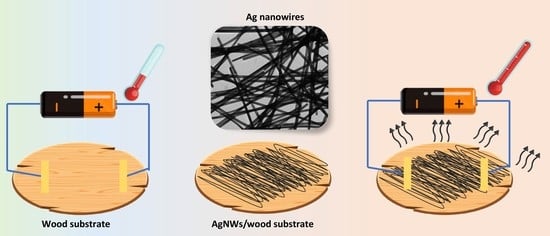Coating Readily Available Yet Thermally Resistant Surfaces with 3D Silver Nanowire Scaffolds: A Step toward Efficient Heater Fabrication
Abstract
1. Introduction
2. Materials and Methods
2.1. Materials
2.2. Synthesis and Characterization of AgNWs
2.3. Deposition of AgNWs Heaters Based on Different Substrates
3. Results and Discussion
3.1. Characterization of the Obtained AgNWs
3.2. Characterization of AgNW-Based Heaters: Temperature-Time Analysis
3.3. Temperature-Input Power Density Analysis
3.4. Temperature-Voltage Characteristics
4. Conclusions
Supplementary Materials
Author Contributions
Funding
Institutional Review Board Statement
Informed Consent Statement
Data Availability Statement
Acknowledgments
Conflicts of Interest
References
- Zhang, M.; Wang, C.; Liang, X.; Yin, Z.; Xia, K.; Wang, H.; Jian, M.; Zhang, Y. Weft-knitted fabric for a highly stretchable and low- voltage wearable heater. Adv. Electron. Mater. 2017, 3, 1700193. [Google Scholar] [CrossRef]
- Jang, N.S.; Kim, K.H.; Ha, S.H.; Jung, S.H.; Lee, H.M.; Kim, J.M. Simple approach to high-performance stretchable heaters based on kirigami patterning of conductive paper for wearable thermotherapy applications. ACS Appl. Mater. Interfaces 2017, 9, 19612–19621. [Google Scholar] [CrossRef] [PubMed]
- Yao, Y.; Fu, K.K.; Yan, C.; Dai, J.; Chen, Y.; Wang, Y.; Zhang, B.; Hitz, E.; Hu, L. Three-dimensional printable high-temperature and high-rate heaters. ACS Nano 2016, 10, 5272–5279. [Google Scholar] [CrossRef] [PubMed]
- Tian, S.; He, P.; Chen, L.; Wang, H.; Ding, G.; Xie, X. Electrochemical fabrication of high quality graphene in mixed electrolyte for ultrafast electrothermal heater. Chem. Mater. 2017, 29, 6214–6219. [Google Scholar] [CrossRef]
- An, B.W.; Gwak, E.J.; Kim, K.; Kim, Y.C.; Jang, J.; Kim, J.Y.; Park, J.U. Stretchable, transparent electrodes as wearable heaters using nanotrough networks of metallic glasses with superior mechanical properties and thermal stability. Nano Lett. 2016, 16, 471–478. [Google Scholar] [CrossRef] [PubMed]
- Wang, R.; Xu, Z.; Zhuang, J.; Liu, Z.; Peng, L.; Li, Z.; Liu, Y.; Gao, W.; Gao, C. Highly stretchable graphene fibers with ultrafast electrothermal response for low-voltage wearable heaters. Adv. Electron. Mater. 2017, 3, 1600425. [Google Scholar] [CrossRef]
- Li, P.; Ma, J.; Xu, H.; Xue, X.; Liu, Y. Highly stable copper wire/alumina/polyimide composite films for stretchable and transparent heaters. J. Mater. Chem. C 2016, 4, 3581–3591. [Google Scholar] [CrossRef]
- Zheng, B.; Zhu, Q.; Zhao, Y. Fabrication of high-quality silver nanowire conductive film and its application for transparent film heaters. J. Mater. Sci. Technol. 2021, 71, 221–227. [Google Scholar] [CrossRef]
- Sui, D.; Huang, Y.; Huang, L.; Liang, J.; Ma, Y.; Chen, Y. Flexible and transparent electrothermal film heaters based on graphene materials. Small 2011, 7, 3186–3192. [Google Scholar] [CrossRef]
- Xu, Z.; Liu, Z.; Sun, H.; Gao, C. Highly electrically conductive Ag-doped graphene fibers as stretchable conductors. Adv. Mater. 2013, 25, 3249–3253. [Google Scholar] [CrossRef]
- Liu, P.; Liu, L.; Jiang, K.; Fan, S. Carbon-nanotube-film microheater on a polyethylene terephthalate substrate and its application in thermochromic displays. Small 2011, 7, 732–736. [Google Scholar] [CrossRef]
- Kim, D.; Lee, H.-C.; Woo, J.Y.; Han, C.-S. Thermal behavior of transparent film heaters made of single-walled carbon nanotubes. J. Phys. Chem. C 2010, 114, 5817–5821. [Google Scholar] [CrossRef]
- Wu, Z.P.; Wang, J.N. Preparation of large-area double-walled carbon nanotube films and application as film heater. Phys. E Low-Dimens. Syst. Nanostruct. 2009, 42, 77–81. [Google Scholar] [CrossRef]
- Kumar, A.; Zhou, C. The race to replace tin-doped indium oxide: Which material will win? ACS Nano 2010, 4, 11–14. [Google Scholar] [CrossRef] [PubMed]
- Hecht, D.S.; Hu, L.; Irvin, G. Emerging transparent electrodes based on thin films of carbon nanotubes, graphene, and metallic nanostructures. Adv. Mater. 2011, 23, 1482–1513. [Google Scholar] [CrossRef] [PubMed]
- Madaria, A.R.; Kumar, A.; Zhou, C. Large scale, highly conductive and patterned transparent films of silver nanowires on arbitrary substrates and their application in touch screens. Nanotechnology 2011, 22, 245201. [Google Scholar] [CrossRef] [PubMed]
- Langley, D.; Giusti, G.; Mayousse, C.; Celle, C.; Bellet, D.; Simonato, J.-P. Flexible transparent conductive materials based on silver nanowire networks: A review. Nanotechnology 2013, 24, 452001. [Google Scholar] [CrossRef] [PubMed]
- Kim, A.; Won, Y.; Woo, K.; Kim, C.-H.; Moon, J. Highly transparent low resistance ZnO/Ag nanowire/ZnO composite electrode for thin film solar cells. ACS Nano 2013, 7, 1081–1091. [Google Scholar] [CrossRef]
- Alqanoo, A.A.; Ahmed, N.M.; Hashim, N.R.; Almessiere, M.A.; Taya, S.A.; Zyoud, S.H. Silver nanowires assisted porous silicon for high photodetector sensitivity using surface plasmonic phenomena. Sens. Actuators A Phys. 2022, 347, 113942. [Google Scholar] [CrossRef]
- Alqanoo, A.A.M.; Ahmed, N.M.; Hashim, M.R.; Almessiere, M.A.; Taya, S.A.; Alsadig, A.; Aldaghri, O.A.; Ibnaouf, K.H. Synthesis and deposition of silver nanowires on porous silicon as an ultraviolet light photodetector. Nanomaterials 2023, 13, 353. [Google Scholar] [CrossRef]
- Liao, Q.; Hou, W.; Zhang, J.; Qin, L. Controllable preparation of silver nanowires and its application in flexible stretchable electrode. Coatings 2022, 12, 1756. [Google Scholar] [CrossRef]
- You, J.; Lee, S.M.; Eom, H.S.; Chang, S.T. Highly transparent conducting electrodes based on a grid structure of silver nanowires. Coatings 2020, 11, 30. [Google Scholar] [CrossRef]
- Wu, X.; Zhou, Z.; Wang, Y.; Li, J. Syntheses of silver nanowires ink and printable flexible transparent conductive film: A review. Coatings 2020, 10, 865. [Google Scholar] [CrossRef]
- Hong, S.; Yeo, J.; Kim, G.; Kim, D.; Lee, H.; Kwon, J.; Lee, H.; Lee, P.; Ko, S.H. Nonvacuum, maskless fabrication of a flexible metal grid transparent conductor by low-temperature selective laser sintering of nanoparticle ink. ACS Nano 2013, 7, 5024–5031. [Google Scholar] [CrossRef] [PubMed]
- Hu, W.; Niu, X.; Zhao, R.; Pei, Q. Elastomeric transparent capacitive sensors based on an interpenetrating composite of silver nanowires and polyurethane. Appl. Phys. Lett. 2013, 102, 38. [Google Scholar] [CrossRef]
- Song, C.; Hwang, H.J.; Kim, J.H.; Hyeon, T.; Kim, D.H. Stretchable heater using ligand-exchanged silver nanowire nanocomposite for wearable articular thermotherapy. ACS Nano 2015, 9, 6626–6633. [Google Scholar]
- Mao, Y.; Hu, L.; Ren, Z.J. Engineered wood for a sustainable future. Matter 2022, 5, 1326–1329. [Google Scholar] [CrossRef]
- Toumpanaki, E.; Shah, D.U.; Eichhorn, S.J. Beyond what meets the eye: Imaging and imagining wood mechanical-structural properties. Adv. Mater. 2021, 33, 2001613. [Google Scholar] [CrossRef]
- Liu, C.; Luan, P.C.; Li, Q.; Cheng, Z.; Xiang, P.Y.; Liu, D.T.; Hou, Y.; Yang, Y.; Zhu, H. Biopolymers derived from trees as sustainable multifunctional materials: A review. Adv. Mater. 2020, 33, 2001654. [Google Scholar] [CrossRef]
- Ajdary, R.; Tardy, B.L.; Mattos, B.D.; Bai, L.; Rojas, O.J. Plant nanomaterials and inspiration from nature: Water interactions and hierarchically structured hydrogels. Adv. Mater. 2020, 33, 2001085. [Google Scholar] [CrossRef]
- Huang, J.L.; Zhao, B.; Liu, T.; Mou, J.; Jiang, Z.J.; Liu, J.; Li, H.; Liu, M. Wood-derived materials for advanced electrochemical energy storage devices. Adv. Funct. Mater. 2019, 29, 1902255. [Google Scholar] [CrossRef]
- Cakici, M.; Kakarla, R.R.; Alonso-Marroquin, F. Advanced electrochemical energy storage supercapacitors based on the flexible carbon fiber fabric-coated with uniform coral-like MnO2 structured electrodes. Chem. Eng. J. 2017, 309, 151–158. [Google Scholar] [CrossRef]
- Sauer, G.; Brehm, G.; Schneider, S.; Nielsch, K.; Wehrspohn, R.B.; Choi, J.; Hofmeister, H.; Gösele, U. Highly ordered monocrystalline silver nanowire arrays. J. Appl. Phys. 2002, 91, 3243–3247. [Google Scholar] [CrossRef]
- Zhang, D.; Qi, L.; Yang, J.; Ma, J.; Cheng, H.; Huang, L. Wet chemical synthesis of silver nanowire thin films at ambient temperature. Chem. Mater. 2004, 16, 872–876. [Google Scholar] [CrossRef]
- Coskun, S.; Aksoy, B.; Unalan, H.E. Polyol synthesis of silver nanowires: An extensive parametric study. Cryst. Growth Des. 2011, 11, 4963–4969. [Google Scholar] [CrossRef]
- Park, J.; Han, D.; Choi, S.; Kim, Y.; Kwak, J. Flexible transparent film heaters using a ternary composite of silver nanowire, conducting polymer, and conductive oxide. RSC Adv. 2019, 9, 5731–5737. [Google Scholar] [CrossRef] [PubMed]
- Huang, Q.; Shen, W.; Fang, X.; Chen, G.; Guo, J.; Xu, W.; Tan, R.; Song, W. Highly flexible and transparent film heaters based on polyimide films embedded with silver nanowires. RSC Adv. 2015, 5, 45836–45842. [Google Scholar] [CrossRef]
- Li, J.; Liang, J.; Jian, X.; Hu, W.; Li, J.; Pei, Q. A flexible and transparent thin film heater based on a silver nanowire/heat-resistant polymer composite. Macromol. Mater. Eng. 2014, 299, 1403–1409. [Google Scholar] [CrossRef]
- Tsapko, Y.; Tsapko, A.; Bondarenko, O. Determination of the laws of thermal resistance of wood in application of fire-retardant fabric coatings. East. -Eur. J. Enterp. Technol. 2020, 2, 104. [Google Scholar] [CrossRef]
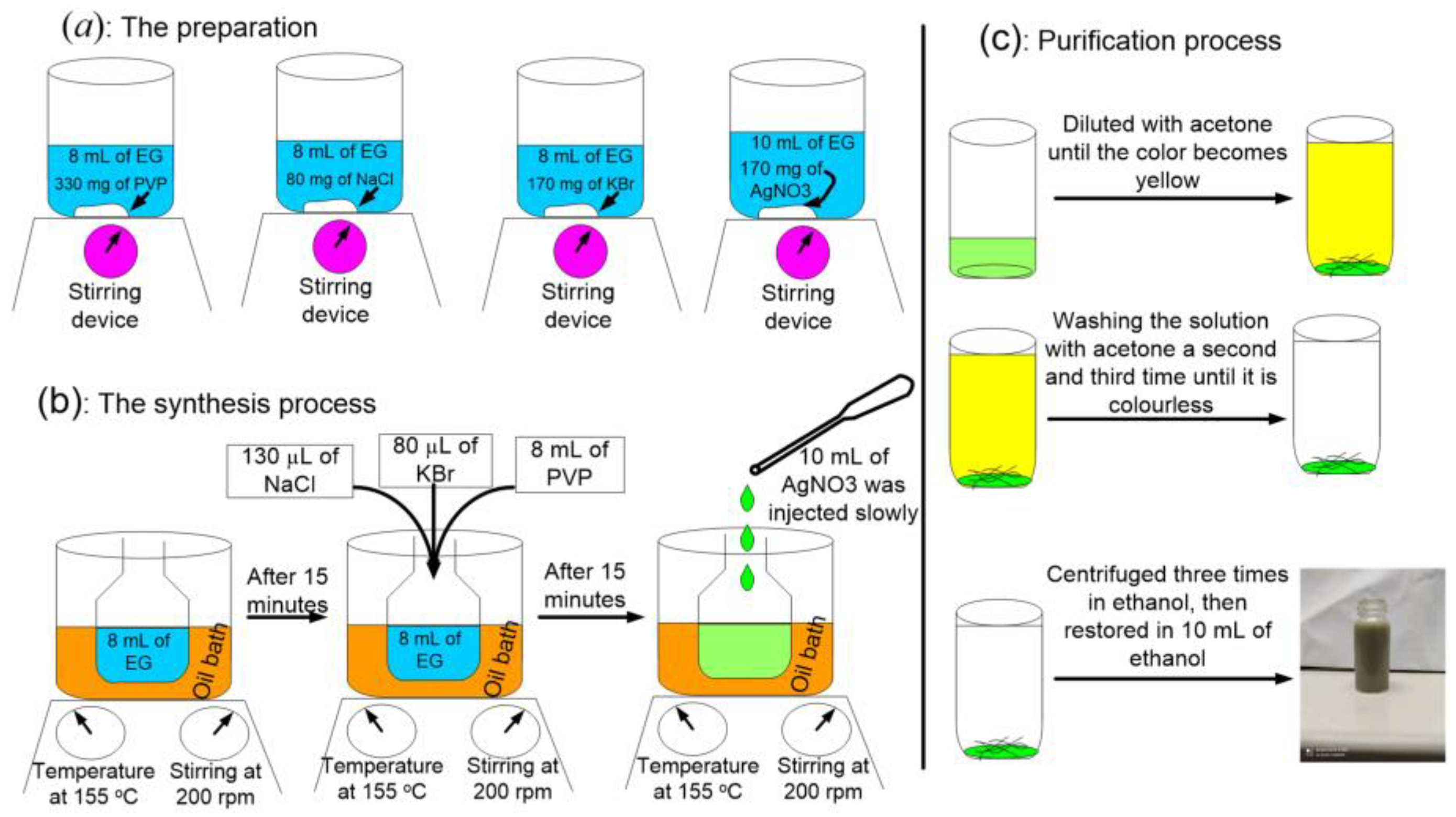
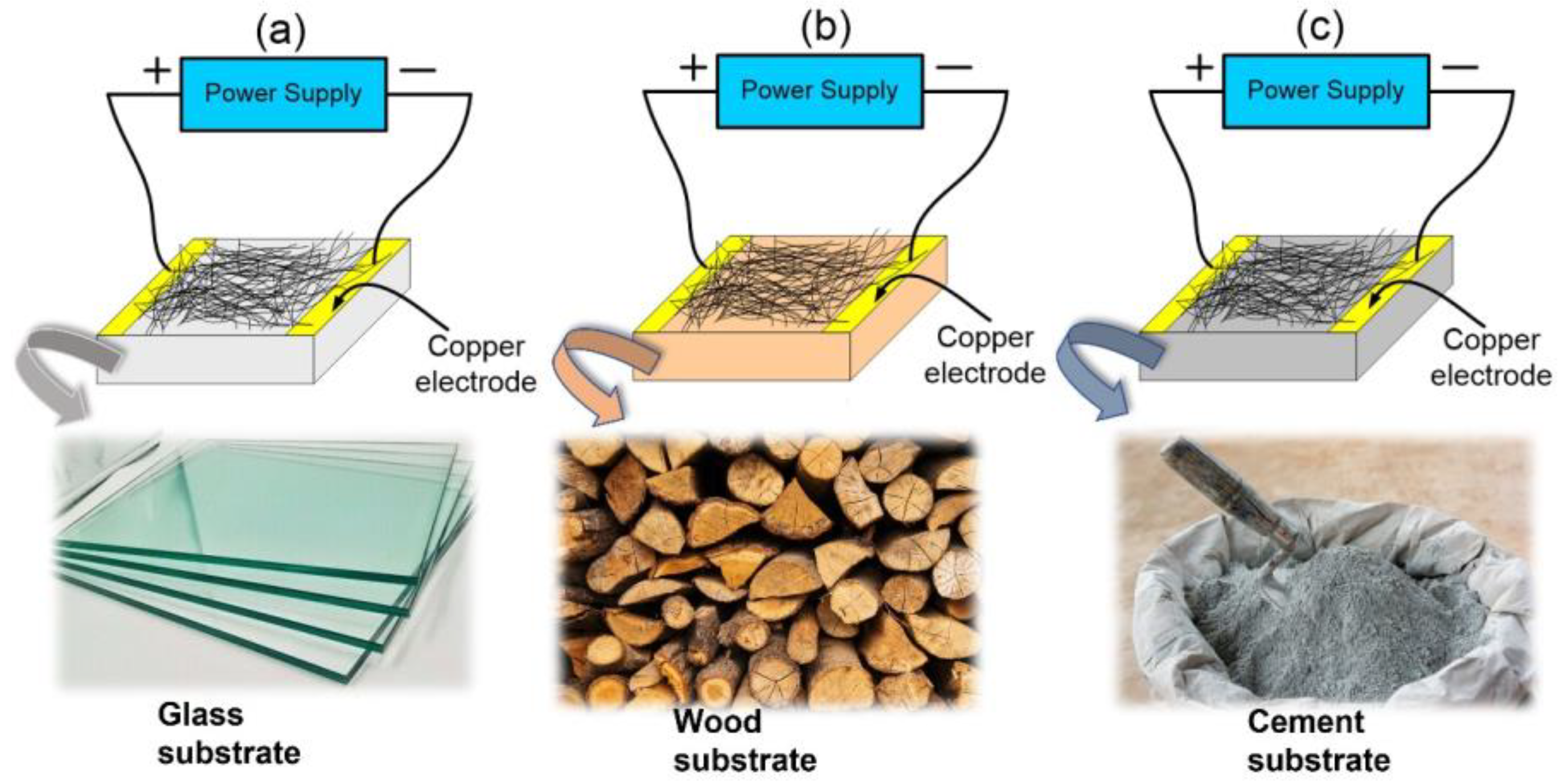
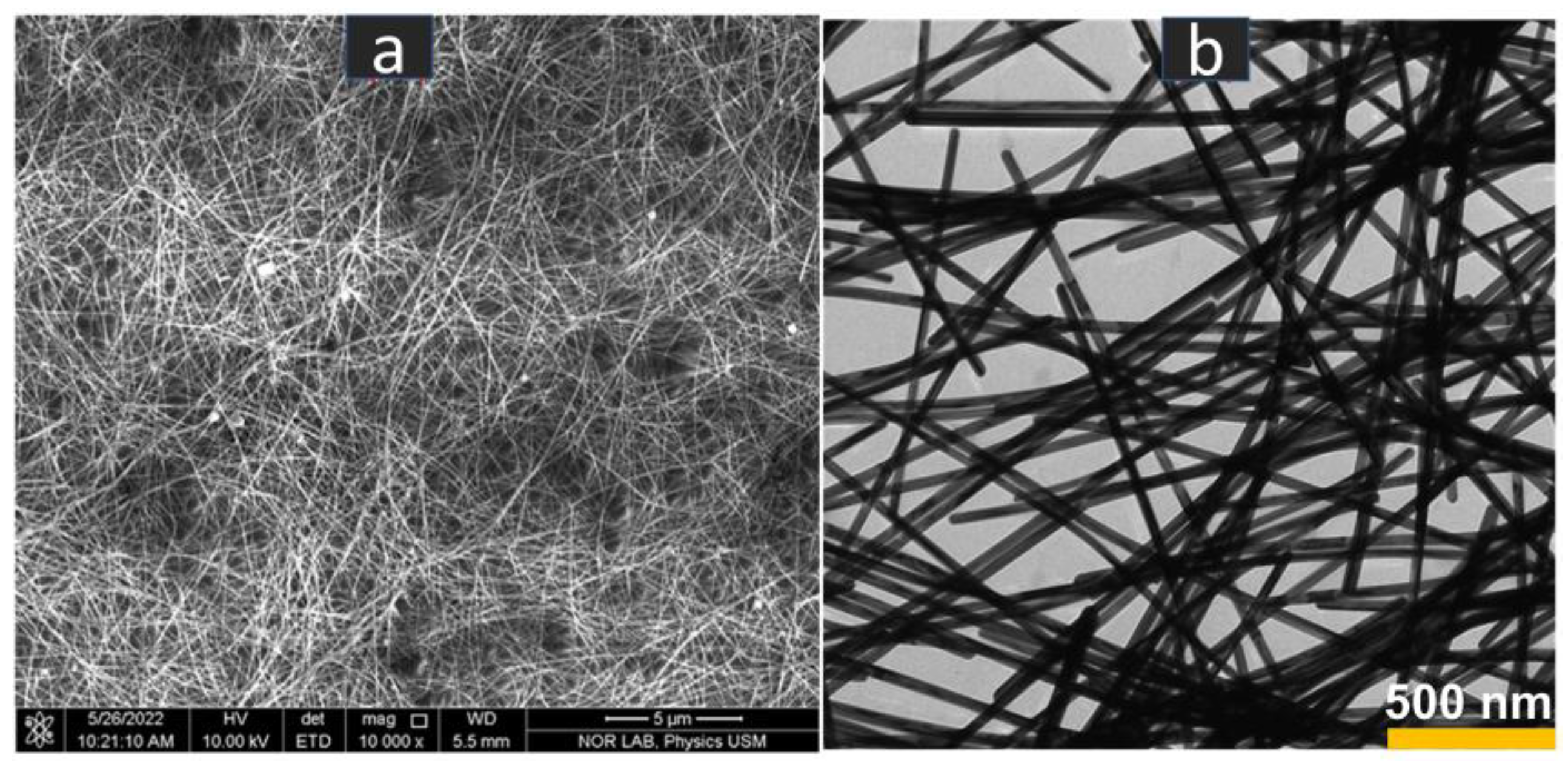

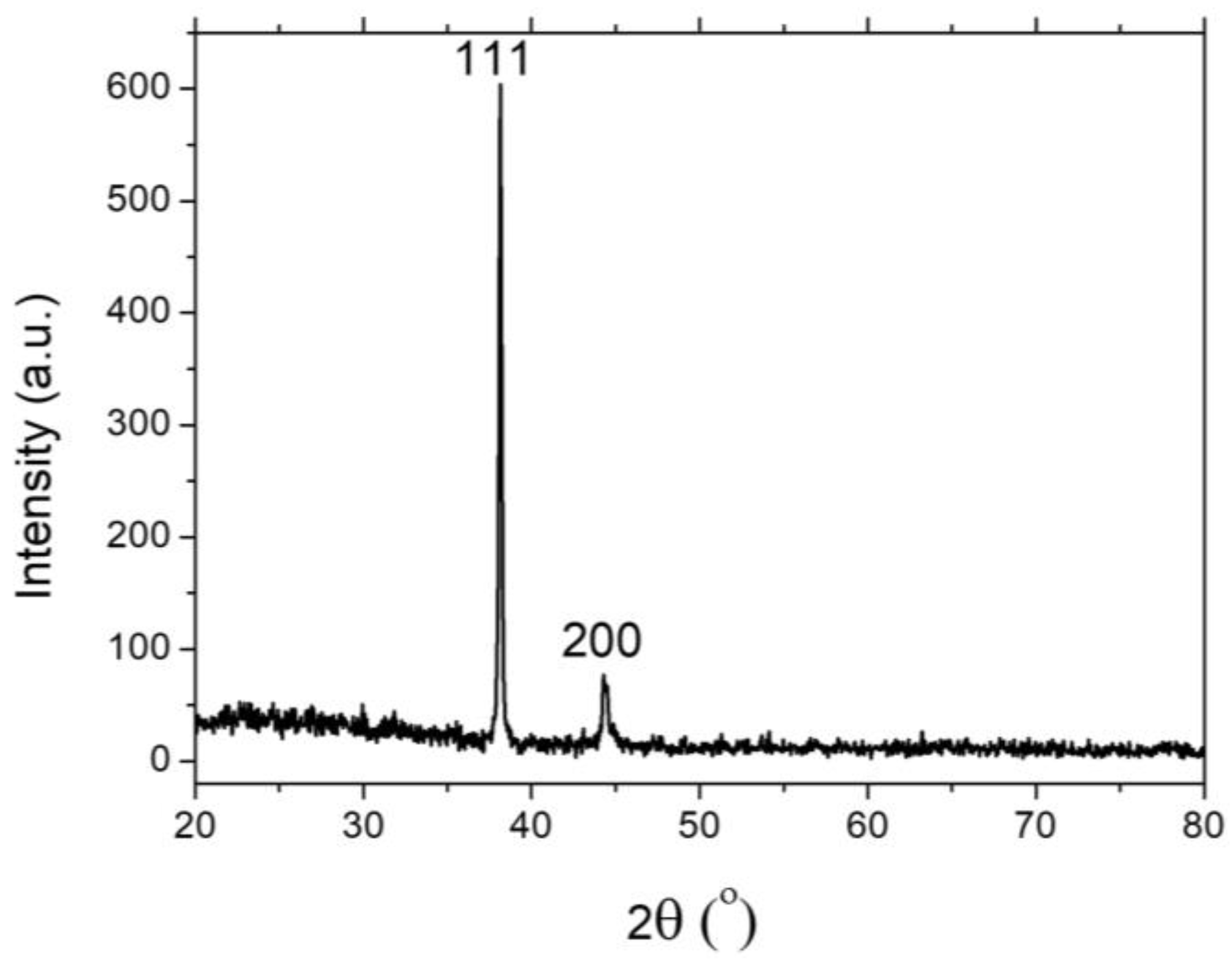
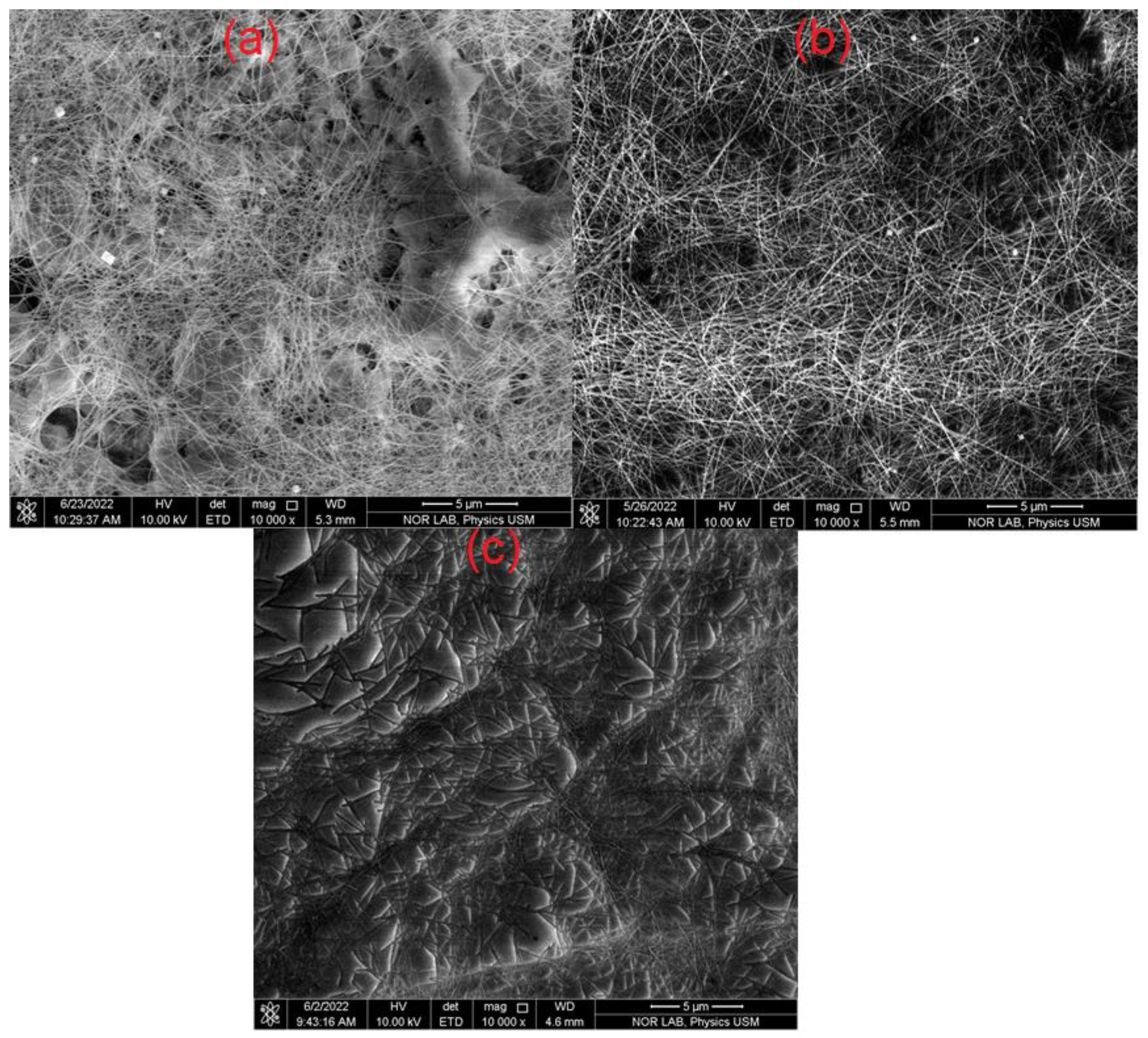
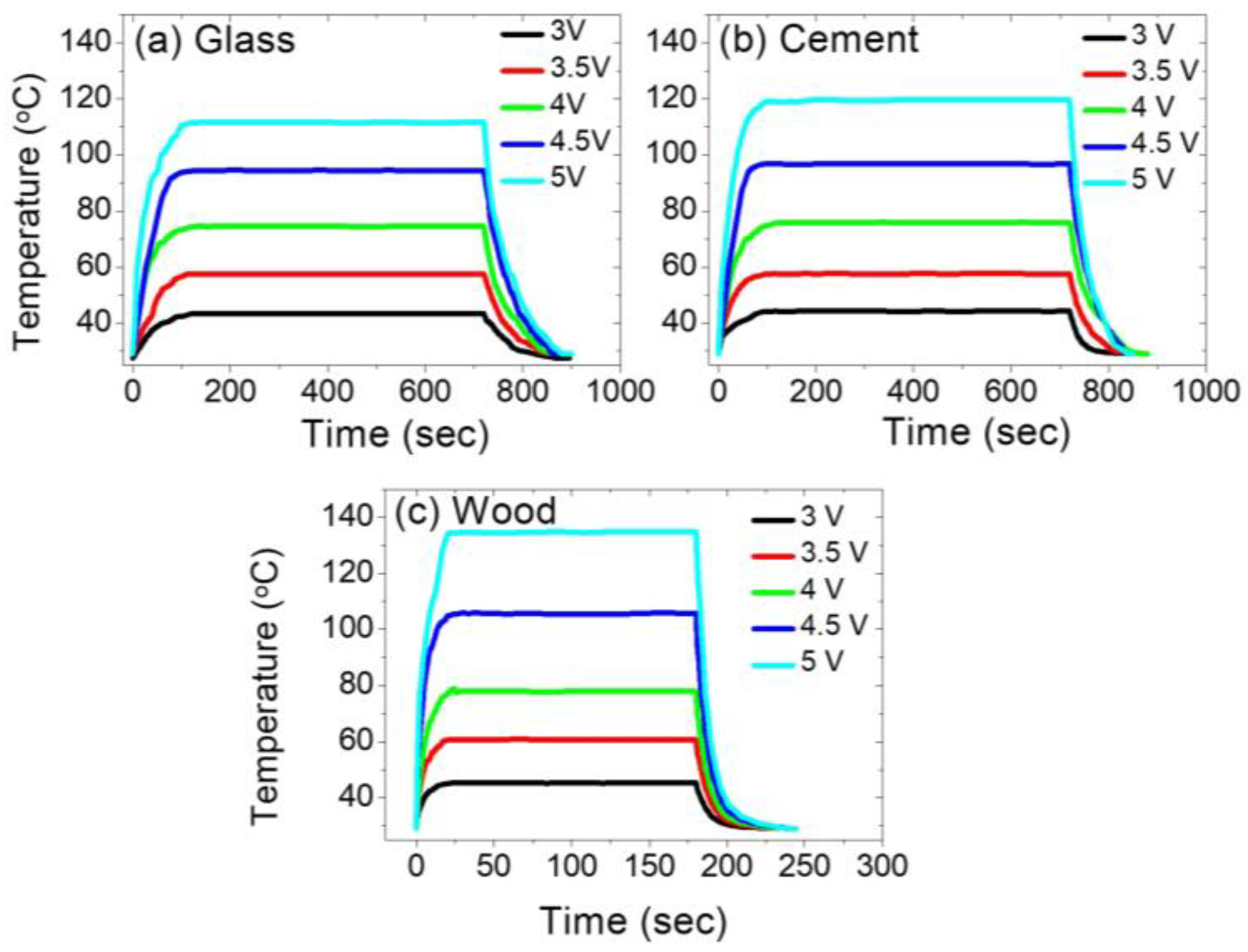

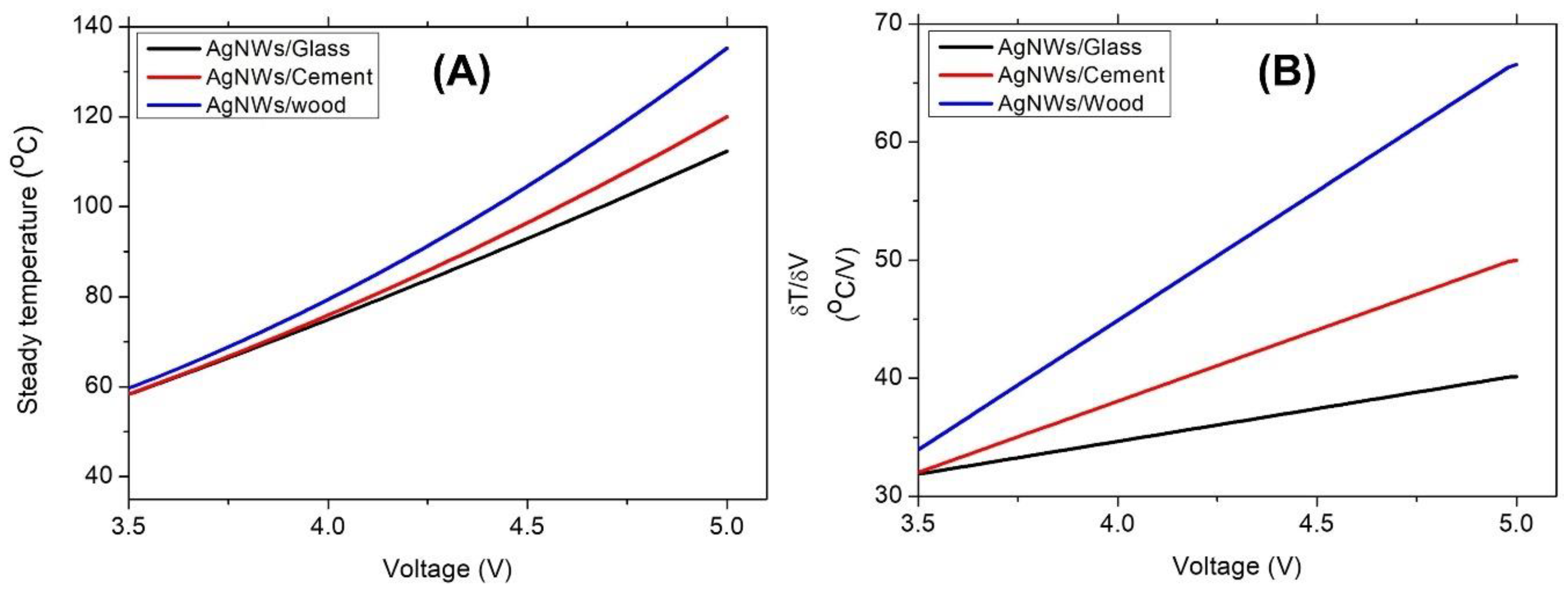
| Heater | Voltage (V) | Response Time (s) | Steady Temperature (°C) | Thermal Resistance °C·cm2/w | Reference |
|---|---|---|---|---|---|
| AgNW-PEDOT: PSS/ITO | 5 | 70 | 43 | 210.3 | [36] |
| AgNW/polyimide | 5 | 40 | 76 | 160.6 | [37] |
| AgNWs/polyacrylate | 5 | 40 | 81 | - | [38] |
| AgNWs/PEDOT: PSS | 5 | 25 | 74.5 | - | [1] |
| AgNWs/glass | 5 | 121 | 112 | 270.25 | Current study |
| AgNWs/cement | 5 | 95 | 120 | 297.77 | Current study |
| AgNWs/wood | 5 | 21 | 135 | 352.59 | Current study |
Disclaimer/Publisher’s Note: The statements, opinions and data contained in all publications are solely those of the individual author(s) and contributor(s) and not of MDPI and/or the editor(s). MDPI and/or the editor(s) disclaim responsibility for any injury to people or property resulting from any ideas, methods, instructions or products referred to in the content. |
© 2023 by the authors. Licensee MDPI, Basel, Switzerland. This article is an open access article distributed under the terms and conditions of the Creative Commons Attribution (CC BY) license (https://creativecommons.org/licenses/by/4.0/).
Share and Cite
Alqanoo, A.A.M.; Ahmed, N.M.; Hashim, M.R.; Alsadig, A.; Al-Yousif, S.; Taya, S.A.; Aldaghri, O.A.; Ibnaouf, K.H. Coating Readily Available Yet Thermally Resistant Surfaces with 3D Silver Nanowire Scaffolds: A Step toward Efficient Heater Fabrication. Coatings 2023, 13, 315. https://doi.org/10.3390/coatings13020315
Alqanoo AAM, Ahmed NM, Hashim MR, Alsadig A, Al-Yousif S, Taya SA, Aldaghri OA, Ibnaouf KH. Coating Readily Available Yet Thermally Resistant Surfaces with 3D Silver Nanowire Scaffolds: A Step toward Efficient Heater Fabrication. Coatings. 2023; 13(2):315. https://doi.org/10.3390/coatings13020315
Chicago/Turabian StyleAlqanoo, Anas A. M., Naser M. Ahmed, Md Roslan Hashim, Ahmed Alsadig, Shahad Al-Yousif, Sofyan A. Taya, Osamah A. Aldaghri, and Khalid Hassan Ibnaouf. 2023. "Coating Readily Available Yet Thermally Resistant Surfaces with 3D Silver Nanowire Scaffolds: A Step toward Efficient Heater Fabrication" Coatings 13, no. 2: 315. https://doi.org/10.3390/coatings13020315
APA StyleAlqanoo, A. A. M., Ahmed, N. M., Hashim, M. R., Alsadig, A., Al-Yousif, S., Taya, S. A., Aldaghri, O. A., & Ibnaouf, K. H. (2023). Coating Readily Available Yet Thermally Resistant Surfaces with 3D Silver Nanowire Scaffolds: A Step toward Efficient Heater Fabrication. Coatings, 13(2), 315. https://doi.org/10.3390/coatings13020315







